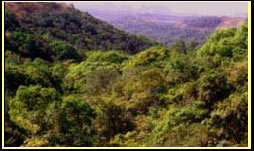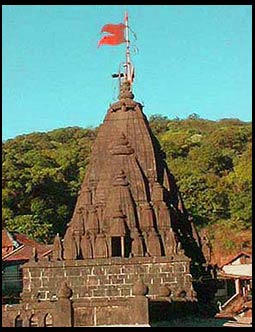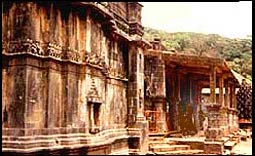|
Travelogues Bhima Shankar: Dwadasha Jyotirlingam
|
|||||
Mount Kailash in the Tibetan Himalayas is Shiva's sacred abode. But Shiva is worshipped everywhere - his temples are found in almost every Indian village and town: under a canopy of trees, in dark caves, in dense forests and in majestic temples. He is worshipped in the cold icy cave of Amarnath, at the five locations of the Panch Kedar, at the 12 sites of the Jyotir Lingas.
|
More on Maharashtra • Forts of Maharashtra
Travelogues
Sacred Space | ||||
This temple is closely associated with the legend of Lord Shiva slaying the demon Tripurasura at the request of the gods. When Bhagwan Shankar, exhausted from the battle, rested, it is said that at the behest of the gods, the streams of sweat that poured from his body became the river Bhimarathi, and because of his promise he remains here permanently in his Bhima form. Though there are references to the place which date back to the Puranas, the modest, unpretentious temple, not more than a couple of centuries old, is a mixture of structures that have been added on over time. The shikhara of the temple was built by Nana Phadnavis. The great Maratha ruler Shivaji is also believed to have been a devotee here.
Darshan at the sanctum sanctorum is, inevitably, a quick in and out - only as long as it takes to be energized by this symbol of eternal light which can keep faith and hope burning in the devotee's heart. Stepping out, I visit the dhuni of Guru Gorakhanth, maintained by the Nath Sampradaya. Here there is silence and the vibrations of an unfathomed depth of meditation. The power and magnetism here is awesome in it's stillness compared to the frenetic worship of the multitudes at the nearby temple. Here, one is alone, almost. Only the occasional sannyasin comes here to offer obeisance to Shiva-Goraksha, the yogic manifestation of Shiva Himself.
|
|||||
Editor: Romola Butalia (c) India Travelogue. All rights reserved. |
|||||
 On my way back from the Kumbha at Nasik in late August 2003, I visited Bhima Shankar temple at the edge of the Sahayadri hills.
On my way back from the Kumbha at Nasik in late August 2003, I visited Bhima Shankar temple at the edge of the Sahayadri hills.
 At a distance of 265 kilometres from Mumbai via Pune by road, Bhimashankar is an extremely picturesque 260 km, 7 hour drive from Mumbai. At about 3,000 feet, beside the source of the Bhimarathi river which later merges into the River Krishna, in the dense unpopulated forests of the Bhimashankar Wild Life Sanctuary, home to wild boars, sambars, hyenas, porcupines and the occasional leopard, is one of the 12 Jyotir Lingams. The monsoon showers had given birth to numerous rivulets and waterfalls that fell in abundance amidst the lush green hills. These hills are stark reminders of the Himalayas in which I have lived and travelled. The thick veil of mist and the surrounding dynamic mountains are deeply reminiscent of some of the well-hidden regions of the Himalayas where worshippers of Shiva seek his darshan.
At a distance of 265 kilometres from Mumbai via Pune by road, Bhimashankar is an extremely picturesque 260 km, 7 hour drive from Mumbai. At about 3,000 feet, beside the source of the Bhimarathi river which later merges into the River Krishna, in the dense unpopulated forests of the Bhimashankar Wild Life Sanctuary, home to wild boars, sambars, hyenas, porcupines and the occasional leopard, is one of the 12 Jyotir Lingams. The monsoon showers had given birth to numerous rivulets and waterfalls that fell in abundance amidst the lush green hills. These hills are stark reminders of the Himalayas in which I have lived and travelled. The thick veil of mist and the surrounding dynamic mountains are deeply reminiscent of some of the well-hidden regions of the Himalayas where worshippers of Shiva seek his darshan. The numerous shops that line the way to the temple sell prasad, various herbs and medicinal plants, and all the items associated with puja. The notable difference is in the offering of flowers. The usual marigold is replaced by a beautiful purple wild flower, surely much more in keeping with the worship of Shiva. The long line snakes down stairs along railings to the temple, beside the kund, where some dip themselves in ritual absolution before offering worship. There is a semblance of order and a quiet patience in the queue. People are chanting Om Namoh Shivaya till the air is rent with that single vibration. The lady in front of me ceases her mala japa to tell me, "This is the 12th Jyotir Lingam of my pilgrimage". I smile fleetingly, reluctant to break my silence. Surely she deserves some human acknowledgement. After awhile, she talks across me to the sannyasin behind me, telling him the same. There is not a flicker of response from him. Have all 12 Jyotir Lingas been equally silent?
The numerous shops that line the way to the temple sell prasad, various herbs and medicinal plants, and all the items associated with puja. The notable difference is in the offering of flowers. The usual marigold is replaced by a beautiful purple wild flower, surely much more in keeping with the worship of Shiva. The long line snakes down stairs along railings to the temple, beside the kund, where some dip themselves in ritual absolution before offering worship. There is a semblance of order and a quiet patience in the queue. People are chanting Om Namoh Shivaya till the air is rent with that single vibration. The lady in front of me ceases her mala japa to tell me, "This is the 12th Jyotir Lingam of my pilgrimage". I smile fleetingly, reluctant to break my silence. Surely she deserves some human acknowledgement. After awhile, she talks across me to the sannyasin behind me, telling him the same. There is not a flicker of response from him. Have all 12 Jyotir Lingas been equally silent?